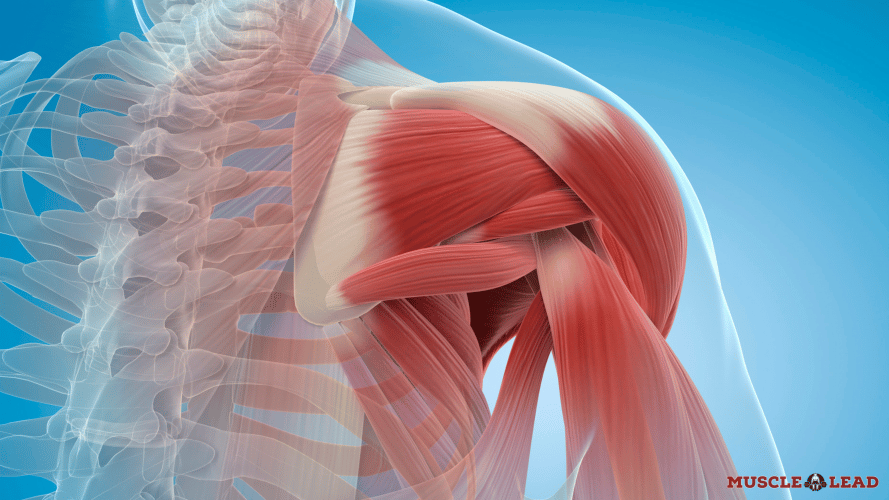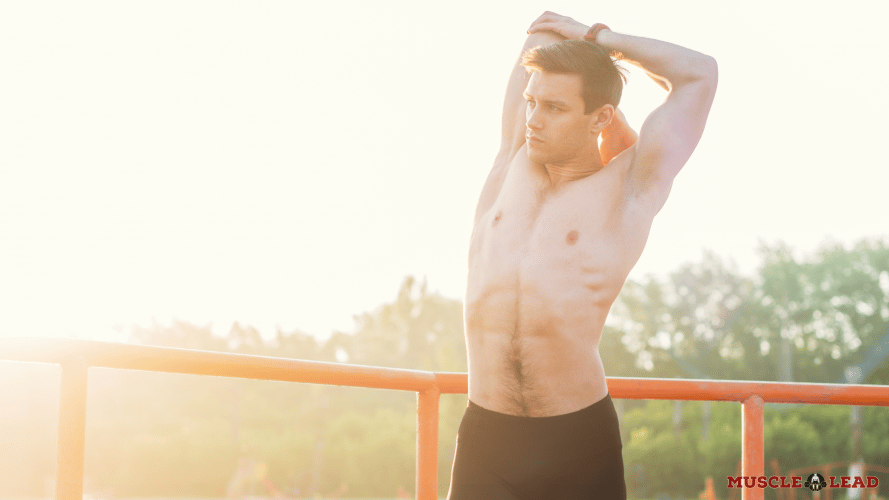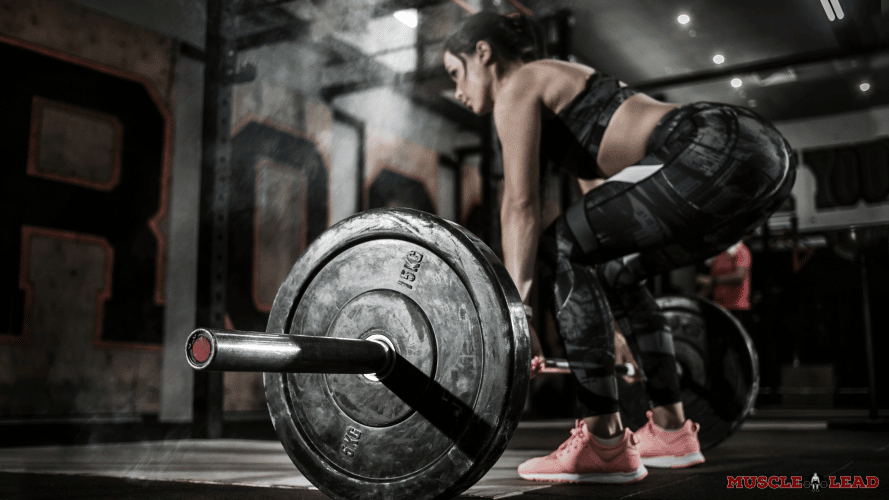The shoulder is a unique ball and socket joint. Some lifters will experience deadlift shoulder pain from time to time.
So how do lifters get shoulder pain from deadlifting? Some common reasons for deadlift shoulder pain include poor mobility, bad technique, or lack of shoulder strength. During the deadlift, lifters should take care to prepare the shoulders for the lift and adequately warm up before. Some lifters may also experience shoulder pain due to overuse and be cautious about how much shoulder volume the program has.
Let’s go over this area of deadlifts using the following guideline
- ‘Shoulder Anatomy & Mechanics’
- ‘The Role Of The Shoulder In Deadlift’
- ‘5 Common Reasons For Shoulder Pain & How To Fix Them’
- ‘Final Thoughts’
- ‘Frequently Asked Questions’
Shoulder Anatomy & Mechanics
There are 3 bones that make up the shoulder, which include:
- Scapula (Shoulder blades)
- Humorous (Upper arm bone)
- Clavicle (Collar bones)
There are 3 main muscle groups that produce shoulder movements, these include:
- Deltoids (front, rear, and middle part of the shoulder)
- Rotators Cuffs (infraspinatus, subscapularis, supraspinatus, teres minor)
- Trapezius (lower, middle and upper part of the upper back)
- Pectorals (Chest muscle)
These muscles attach to certain areas of the bones that help with shoulder movements. I have highlighted the muscles, their attachments and movement actions below. (1)

Deltoids
The Deltoids attach to parts of the clavicle, scapula, and are humorous. Therefore, this muscle group can help lift the upper arm away from the front and side. Moreover, it also helps to pull the upper arm backwards.
Rotator Cuff
These muscles need to be considerably stronger to perform the deadlift. All 4 of these muscles attach to the shoulder blades and the upper arm bone.
The movements the Rotators perform is in the name, they rotate the shoulder in, out, and help lift the shoulders away from the body.
Trapezius
The trapezius is the muscle of the upper back, but attaches to the back of the skull, Clavicle, and scapula which are a part of the shoulder.
This explains why this large muscle helps to pin the shoulder blades backwards and flare them forwards. Not only that, they help shrug the shoulders up and down.
Pectorals
This one might come as a surprise to some, but the pecs are actually a part of the shoulders. The pecs are connected to the ribcage, clavicle and humerus. They help to twist the shoulder inwards, move the upper arm forward, and across the body.
The Role Of The Shoulder In Deadlift
This will probably make more sense to you now, as you have probably got your head around the anatomy and mechanics of the shoulder joint.
As complex as the following movements sound, I promise to break them down in simple terms.
During the set up the deadlift draws in:
- Shoulder flexion
- Shoulder Internal Rotation
While lifting the bar upwards the shoulders perform a:
- Isometric Shoulder Brace
To finalize the deadlift we will see:
- Shoulder External Rotation
- Shoulder Vertical Extension
- Scapula Retraction
While Setting Up
While setting up the deadlift, a lifter would flex the shoulder forward and internally rotate to it to some extent.
These movements are formally known as bringing the upper arm forward and twisting them inwards.
How to Fix Deadlift Elbow Pain: 13 Solutions
During The Lift
During the deadlift, the muscles surrounding the shoulder joint come together, brace and work isometrically to maintain a straight bar path and not drift in any direction.
Finalizing the Lift
This is the final pull just before dropping the weight back to the ground, a lifter would externally rotate the shoulder, while vertically extending the arm then retracting the scapula.
In simple words, this means twist the arm outwards, while moving the shoulder back and pinning the shoulder backwards.
5 Common Reasons For Deadlift Shoulder Pain & How To Fix
1. Not Warming Up The Shoulders Properly
We have all heard it before ‘don’t forget to warm up’. You might be asking, ‘but what does warming up actually do?’
Warming up lubricates the working joints with a synovial fluid and raises core body temperature. Inturn, this can help make the muscles and joints more pliable for the deadlifts (2).
So what could happen if you forget to warm up the shoulder? Well this is risky business, especially if you attempt a heavy deadlift. There is a chance of over stretching a muscle, followed by muscle strain or joint sprain (2).
For example, a common problem I see a lot is shoulder rotator cuff strain, which is accompanied by a lot of pain depending on the severity of the injury grade i.e., grade 1 = pull and grade 3 = rupture.
How to Warm Up The Shoulder?
Specially for the deadlift I recommend first warming up the rotator cuffs by using an exercise at a very low intensity, that twists the shoulders outwards, inwards, and lifts it from the side of the body, like a shoulder fly movement.
The second exercise that I recommend is a few sets of low-moderate intensity rack pulls or deadlifts, perhaps 60% intensity for 15 reps for 2 sets?
These exercises will warm up the specific shoulder parts that will be targeted during working sets. It only makes sense right?
2. Poor Chest Mobility
All lifters get this problem from time to time, but luckily it is a quick fix. Months and months of chest days can build up ground substance and tighten the surrounding muscles and tendons.
Other times, lifters favor the chest workouts so much that they form a muscle imbalance between the front and back of the upper body. In other words, too many chest days and not enough back days.
Either of these problems causes an upper crossed syndrome (3), which is the technical term for the shoulders being hunched forward.
The chest works as the antagonist (pulls in the opposite direction) during the deadlift, especially while pinning the shoulder blades backwards.
Having the upper crossed syndrome would likely take the glenohumeral joint out of its natural position while deadlifting. This literally destroys the deadlift form and causes a grinding of the joint shoulder joint in its socket.
Now it probably will not come as a surprise that this type of posture can cause shoulder pain and even injury, of either the shoulder joint or shoulder blade.
How To Fix Chest Mobility
So there is a quick fix for tight muscles, but muscle imbalances may take a little longer.
To Fix a tight chest you could simply do some foam rolling and loosen out the muscle and then stretch it.
The way you would go about this is to find the most tender points in the chest, then press and roll into it for 30 seconds. Finish off by stretching the chest for 30 seconds (2-3 sets) (4).
The second method would be to fix the imbalance between the chest/front shoulders and the back.
Addressing this type of muscle imbalance would be entirely Individual, but in general I recommend including more back work and less chest work in your program.
3. Poor Shoulder Mobility
Another area that commonly gets tight is the shoulders itself. Do you remember when I mentioned that throughout the deadlift, the shoulders push the arms forward, brace, and pull back at the end?
Possessing tight shoulder muscle would hinder these positions and ultimately cause an improper form, followed by pain or injury.

Something as small as this could even offset the natural spine position, from having to compensate.
For example, tight front shoulders might not allow a lifter to draw into the flexed deadlift position, where the spine may be forced to curve to reach the bar.
I have always said it, spinal neutrality is absolutely crucial. If it is not maintained throughout the deadlift, dire consequences could erupt like damage to the disks of the spine.
How To Fix Shoulder Mobility
You could probably guess this one from our last point. So using a foam roller or a tennis ball, you could find the tender points and press into it with the same manner as I mentioned for the chest.
4. Improper Bracing Of The Shoulder Joint
After setting up one of my key lifting pointers is to brace the shoulders. This helps to stabilize the movement and keeps the shoulder joint locked in.
What could happen if this was not checked? There is a good chance that you could pop your shoulder out of the socket resulting in a dislocation, especially while working within higher intensities.

How to Brace The Shoulder Joint During The Deadlift
Make the intention to keep the shoulders locked into the socket by bracing and digging the shoulder blades downwards.
5. Using The Mix Grip
This mixed grip is one hand over and one hand under, as shown in the image. I have never been an advocate of the mixed grip, without sounding too aggressive I really dislike it.
The amount of distal bicep tears that we see from this grip is ridiculous, take a look (5) but I WARN you, it is not for the faint hearted. This is another rant all together.
To keep things relevant, let us answer how the mixed grip causes shoulder pain. The long head bicep tendon (outer part) connects into the shoulder. After a period of time, this grip could bring out an overuse of bicep tendonitis, which would mimic shoulder pain.
Which Deadlift Grip To Use Instead
My suggestions would be to simply use the double overhand flip or hook grip, which is a lot safer. At the very least, you could alternate between a mixed and double over hand, giving the tendons some time to recover.
How to Maximize Your Deadlift Grip
Final Thoughts
As a take home message, to avoid deadlift shoulder pain follow a few fixes and understand the reasons.
Always warm up the shoulders properly before deadlift. Keep the chest and shoulder muscles in check with occasional tissue release.
During the lift, brace the shoulder joint and shoulder blades while deadlifting. Avoid the mixed grip or at least alternate it to prevent overuse.
Frequently Asked Questions
Quite possible! This can even cause shoulder injury. My suggestion would be to strengthen the muscles surrounding the joint before starting heavy deadlifts
Anything solid that can add pressure to a muscle. Some objects are smaller and can target muscles that are difficult to reach. Personally I have used a lacrosse ball, golf ball, or a baseball.
References
- Murray, L.R., Goudie, E.B., Petrigliano., et al. ‘Functional anatomy and biomechanics of shoulder stability in the athlete’ Clinics In Sports Medicine. 2013;32 (4): 607–624
- McCary, M.J., Ackermann, B.j., Halaki, M. ‘A systematic review of the effects of upper body warm-up on performance and injury’ British Journal Of Sports Medicine. 2015; 49 (14): 935–942
- Mascolino, J. ‘Upper Crossed Syndrome’ Journal Of Traditional-Medicine Society. 2015; 21 (2): 80–85
- Nakamura, M., Onumi, R., Kiyoni, R., et al. ‘The Acute and Prolonged Effects of Different Durations of Foam Rolling on Range of Motion, Muscle Stiffness, and Muscle Strength’ Journal Of Sport Science & Medicine. 2021; 20 (1): 62–68
- Daniel Koffler (2011). ‘Bicep Tendon Tear – – Deadlift’ Available at:https://youtu.be/Wjq82nYPUeo (Accessed 2/01/2023)





